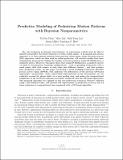| dc.contributor.author | Chen, Yu Fan | |
| dc.contributor.author | Liu, Miao | |
| dc.contributor.author | Liu, Shih-Yuan | |
| dc.contributor.author | Miller, Justin Lee | |
| dc.contributor.author | How, Jonathan P | |
| dc.date.accessioned | 2018-04-13T18:32:35Z | |
| dc.date.available | 2018-04-13T18:32:35Z | |
| dc.date.issued | 2016-01 | |
| dc.identifier.isbn | 978-1-62410-389-6 | |
| dc.identifier.uri | http://hdl.handle.net/1721.1/114717 | |
| dc.description.abstract | For safe navigation in dynamic environments, an autonomous vehicle must be able to identify and predict the future behaviors of other mobile agents. A promising data-driven approach is to learn motion patterns from previous observations using Gaussian process (GP) regression, which are then used for online prediction. GP mixture models have been subsequently proposed for finding the number of motion patterns using GP likelihood as a similarity metric. However, this paper shows that using GP likelihood as a similarity metric can lead to non-intuitive clustering configurations - such as grouping trajectories with a small planar shift with respect to each other into different clusters - and thus produce poor prediction results. In this paper we develop a novel modeling framework, Dirichlet process active region (DPAR), that addresses the deficiencies of the previous GP-based approaches. In particular, with a discretized representation of the environment, we can explicitly account for planar shifts via a max pooling step, and reduce the computational complexity of the statistical inference procedure compared with the GP-based approaches. The proposed algorithm was applied on two real pedestrian trajectory datasets collected using a 3D Velodyne Lidar, and showed 15% improvement in prediction accuracy and 4.2 times reduction in computational time compared with a GP-based algorithm. | en_US |
| dc.description.sponsorship | Ford Motor Company | en_US |
| dc.publisher | American Institute of Aeronautics and Astronautics (AIAA) | en_US |
| dc.relation.isversionof | http://dx.doi.org/10.2514/6.2016-1861 | en_US |
| dc.rights | Creative Commons Attribution-Noncommercial-Share Alike | en_US |
| dc.rights.uri | http://creativecommons.org/licenses/by-nc-sa/4.0/ | en_US |
| dc.source | MIT Web Domain | en_US |
| dc.title | Predictive Modeling of Pedestrian Motion Patterns with Bayesian Nonparametrics | en_US |
| dc.type | Article | en_US |
| dc.identifier.citation | Chen, Yufan, Miao Liu, Shih-Yuan Liu, Justin Miller, and Jonathan P. How. “Predictive Modeling of Pedestrian Motion Patterns with Bayesian Nonparametrics.” AIAA Guidance, Navigation, and Control Conference, January 2016, San Diego, California, USA, American Institute of Aeronautics and Astronautics (AIAA), 2016.. | en_US |
| dc.contributor.department | Massachusetts Institute of Technology. Department of Aeronautics and Astronautics | en_US |
| dc.contributor.department | Massachusetts Institute of Technology. Department of Mechanical Engineering | en_US |
| dc.contributor.department | Massachusetts Institute of Technology. Laboratory for Information and Decision Systems | en_US |
| dc.contributor.mitauthor | Chen, Yu Fan | |
| dc.contributor.mitauthor | Liu, Miao | |
| dc.contributor.mitauthor | Liu, Shih-Yuan | |
| dc.contributor.mitauthor | Miller, Justin Lee | |
| dc.contributor.mitauthor | How, Jonathan P | |
| dc.relation.journal | AIAA Guidance, Navigation, and Control Conference | en_US |
| dc.eprint.version | Author's final manuscript | en_US |
| dc.type.uri | http://purl.org/eprint/type/ConferencePaper | en_US |
| eprint.status | http://purl.org/eprint/status/NonPeerReviewed | en_US |
| dc.date.updated | 2018-03-21T17:16:33Z | |
| dspace.orderedauthors | Chen, Yufan; Liu, Miao; Liu, Shih-Yuan; Miller, Justin; How, Jonathan P. | en_US |
| dspace.embargo.terms | N | en_US |
| dc.identifier.orcid | https://orcid.org/0000-0003-3756-3256 | |
| dc.identifier.orcid | https://orcid.org/0000-0002-1648-8325 | |
| dc.identifier.orcid | https://orcid.org/0000-0002-9838-1221 | |
| dc.identifier.orcid | https://orcid.org/0000-0002-4621-2960 | |
| dc.identifier.orcid | https://orcid.org/0000-0001-8576-1930 | |
| mit.license | OPEN_ACCESS_POLICY | en_US |
